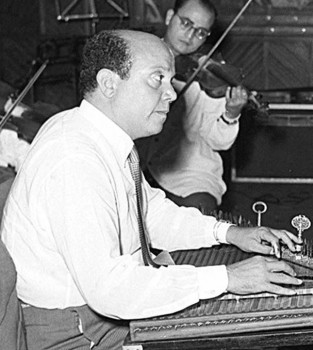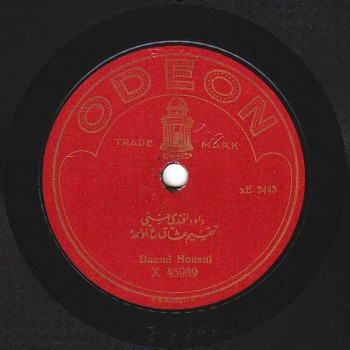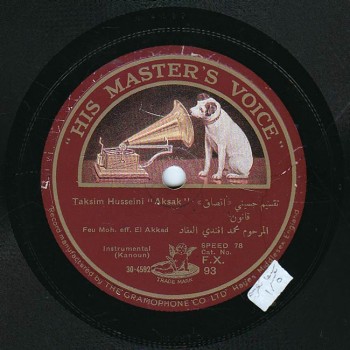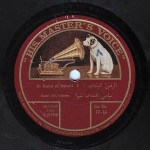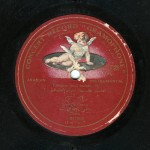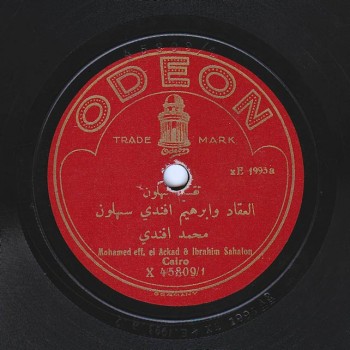 The Arab Music Archiving and Research foundation (AMAR), in collaboration with the Sharjah Art Foundation (SAF), presents “Niẓāmunā al-Mūsīqī”.
The Arab Music Archiving and Research foundation (AMAR), in collaboration with the Sharjah Art Foundation (SAF), presents “Niẓāmunā al-Mūsīqī”.
Dear listeners,
Welcome to a new episode of “Niẓāmunā al-Mūsīqī”.
Today, we will resume our discussion about the taqsīm and its different types.
We will resume the subject started in our previous episode about the taqsīm muwaqqa‘ to a cyclic rhythm.
Some instrumentalists preferred rhythms free from the melodic zanna –for example, the riqq had to be played without any instrument giving the maqām’s fundamental position– notably Dāwūd Ḥusnī, one of the major composers of his generation who made many recordings of taqsīm on his ‘ūd, including the following taqsīm to the bamb/’ushshāq recorded around 1921 by Odeon on one side of a 27cm record, # X-45989, matrix # EX 2443, accompanied by Muḥammad ‘Alī Lu‘ba (percussions)…
(♩)
Dāwūd’s system is the one that remained after the fallback of the movement of modernization and after the types of taqsīm were mostly limited to taqsīm fālit mursal (free), while some instrumentalists continued to play taqsīm muwaqqa‘ to a cyclic rhythm especially to the bamb, notably qānūnist Muḥammad ‘Abduh Ṣāliḥ who preserved the nature of the Arabic qānūn despite the modernization.
Let us listen to his recording of a taqsīm to the bayyātī, accompanied by Ḥusayn Mu‘awwaḍ (percussions), made on a 33rpm disc produced by Ṣawt al-Qāhira and dedicated to Muḥammad ‘Abduh Ṣāliḥ …
(♩)
The taqsīm mushtarak also appeared as a muwaqqa‘ form and seems, as we mentioned, to have originated from the dialogues between the muṭrib and the instruments after the end of the dawr, or before or after the qaṣīda ‘ala al-waḥda.
At the beginning of the recording era, the taqsīm mushtarak ‘ala al-waḥda did not spark a lot of interest. Still, some samples were found, including a taqsīm mushtarak ‘ala al-bamb between Muḥammad al-‘Aqqād and Ibrāhīm Sahlūn performed to the bayyātī/bamb, recorded around 1908 by Odeon on one side of a 27cm record, # X 45809-1, matrix # EX 1993 A2…
(♩)
The second rhythm that sparked the interest of the instrumentalists in the taqsīm is the aqṣāq, a 9-pulse’ a‘raj rhythm whose trochee is close the baḥr majzū’ al-ramal’s.
There are also some taqsīm layālī to the aqṣāq that may have been reflected in live performances, for example as a conclusion to the muwashshaḥ composed to this rhythm, of to dawr composed to it.
As an example of the aqṣāq, let us listen to a taqsīm to the ḥusaynī performed by Muḥammad al-‘Aqqād and recorded around 1930 by His Master’s Voice on one side of a 25cm record, # 30-4592, matrix # BG 487, accompanied by Sāmī al-Shawwā (kamān) and Maḥmūd Raḥmī (percussions)…
(♩)
Dear listeners,
We have reached the end of today’s episode of “Niẓāmunā al-Mūsīqī”.
We will meet again in a new episode to discuss the different types of taqsīm.
“Niẓāmunā al-Mūsīqī” is brought to you by Mustafa Said.
- 221 – Zakariyya Ahmed – 12 (1/9/2022)
- 220 – Zakariyya Ahmed – 11 (1/9/2022)
- 219 – Zakariyya Ahmed – 10 (11/25/2021)
- 218 – Zakariyya Ahmed – 9 (10/26/2021)
- 217 – Zakariyya Ahmed – 8 (9/24/2021)
- 216 – Zakariyya Ahmed – 7 (9/4/2021)
- 215 – Zakariyya Ahmed – 6 (8/28/2021)
- 214 – Zakariyya Ahmed – 5 (8/6/2021)
- 213 – Zakariyya Ahmed – 4 (6/26/2021)
- 212 – Zakariyya Ahmed – 3 (5/27/2021)
- 211 – Zakariyya Ahmed – 2 (5/1/2021)
- 210 – Zakariyya Ahmed – 1 (4/28/2021)
- 209 – W-al-Lāhi lā astaṭī‘u ṣaddak 2 (4/6/2017)
- 208 – W-al-Lāhi lā astaṭī‘u ṣaddak 1 (3/30/2017)
- 207 – Bashraf qarah baṭāq 7 (3/23/2017)

